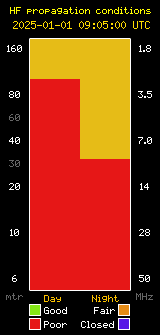When I was a young lad, messing around on the 11m CB bands and theoretically pushing the boundaries of my theoretical CB licence theoretically quite a lot, there were certain radios and certain bits of kit which marked some of the operators out as being pretty cool. I spent probably too much money on some of the shiny things that were offered to me by some of my friends who were amateurs, and some of whom were 'rig doctors' as we used to call them. One of them was a very well-known and respected electrical engineer, and I remember the first time I dropped my radio off to him for a re-tune and one or two 'enhancements'.
His property was absolutely chock-full of radio exotica - every room, including the kitchen, was stacked with the radios that we all coveted at the time, and more test gear than you could shake a stick at. Huge power supplies, linears, oscilloscopes, signal generators and various meters, analysers and other lab gear.
The one thing though, that just seemed way more impressive and desirable than anything else were the big digital frequency counters. They were DIGITAL, even though they were of course totally analogue apart from the bright, colourful seven-segment LED displays.
I really wanted one, but they were just too expensive for the likes of me to purchase.
Now that I'm old and can no longer remember what I had for lunch, I still want one. I bought one of those super-cheap Chinese frequency counters off eBay for about a tenner. It looked interesting, but was about as useful as a chocolate teapot. Several weeks later I found a job lot of radio bits and bobs from an SK shack sale. It was cheap, and included in the bundle was a much better-looking portable frequency counter, so I pulled the trigger.

It's been an interesting gadget to get to know. Certainly not a professional piece of equipment, but useful and yet another opportunity to learn about amateur radio and RF technology in general.
So it turns out that I don't have enough hands to key a radio to generate a test signal, press the buttons on the frequency counter, and photograph it all happening - so I fired up my beloved WSJT-X and transmitted a 'Tune' signal on 20m. That allowed me just enough hands to hang out of the upstairs window and wave the counter in the direction of my wire antenna. The counter has a run/stop scan function so you can freeze the current screen image. That way I could then get a reasonable photo with both feet on the ground.
Above, you can see the result of my first test. Initially it was a little bit nerve-racking, because the manual warns repeatedly about not overwhelming the input of the meter with significant amounts of RF at close range, so I started off cautiously, and then generally upped the ante until I got some sensible output.
I was quite impressed. The display was large enough to be perfectly readable even with these aged peepers, and the frequency reading was reasonably accurate. I of course checked the figures I was seeing with another reference receiver, and yes - pretty good results. Signal strength indication is also noteworthy, though not that useful as both the distances involved, slight variations in orientation/polarisation as well as the proximity of other real-world objects made it less than reproducible shall we say.
The meter covers a vast frequency range from 2MHz all the way up to 2800MHz so after larking about on the HF bands, I thought I'd test it out on UHF - including the fact that it will also supposedly read the CTCSS tones used to open analogue repeaters.
Lo and behold, it grabbed the following from GB3HY

I was again more than satisfied with the accuracy and ease of use. I obtained this reading by throwing some RF around my shack using a homemade indoor 2m/70cms dipole at approximately 2W output. The meter had no problem with ascertaining both primary and sub-frequencies correctly.
After a bit more testing and playing with all the settings and ranges, I returned to HF and performed a check on 40m FT8.
Of course, that will give me 7.074MHz or thereabouts...

Turns out that it's also a useful tool for checking your unwanted harmonic outputs!

That was 50W full duty cycle at around ten feet from the antenna, and with the range (mistakenly) set to 27MHz - 2.8GHz, it was never going to read 7MHz. I was childishly excited to see the 7th harmonic registering on the counter though.
As far as I remember, the actual transmit frequency was around 7.073500MHz, so I'm not really sure why the counter reads what it does, or why it didn't pick up the 5th harmonic for example, but it does also have an f2 reading of 50.4809MHz.
I guess there is more experimenting and testing to be done. I might even consider reading the manual.
It only took me 40 years to get to this point. Not so cool after all, though I try to appease my ego by imagining that I must be a tad wiser and have slightly better dress sense.
Berni M0XYF



